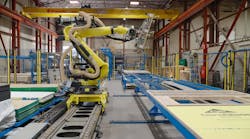Network capabilities of building control systems historically have lagged behind other networked-based systems. And hardwired connections for each input/output (I/O) point remain the most popular means of connecting end devices to these systems. This needs to change and change quickly. Here are three reasons why.
1. End devices are rapidly growing in both capabilities and complexity. For example, why install just a single-space temperature sensor for each variable-air-volume (VAV) zone when a single device today can economically provide temperature, humidity, occupancy, and lighting control as well as environmental data for demand ventilation? Such devices can easily be placed in every office or near every workstation in the zone with simple network connections, enabling buildings to become much more comfortable and efficient.
2. The lower-level building control networks today are notoriously unreliable. As a result, many still recommend limiting network connections to providing non-critical information to the operator. Requiring both network and discrete I/O connections adds expense and leads to point duplication and confusion.
3. Most importantly, he current explosion of inexpensive wireless devices and subsystems greatly reduces device-installed cost and makes it imperative that building-control system manufacturers refocus their attention to expanding and improving the network capabilities of their controllers to more effectively accommodate these new lines of devices and equipment to better instrument and control occupied spaces.
At the same time building control networks are improved, another important question must also be addressed. How and where will this networked data be brought into the network so that it can be efficiently managed? One reason this question must be answered is that manufacturers still visualize building control systems as relatively small compared to what they could and should be. Today, a building control system of a few thousand I/O points is considered by many a large system. But to create really comfortable and efficiently conditioned building spaces we need to integrate much more space temperature, humidity, indoor-air quality, and occupant interface instrumentation. Today, building control systems of many thousands of instrumentation/control points could and should be configured to serve just average sized commercial buildings.
The problem with this explosion of device and subsystem connectivity — and data — is that standards have encouraged what I call “virtually flat” system architecture wherein all I/O points, no matter where they are or how they connect to the system, are accessed identically. While this uniform accessibility is certainly important, the current means to achieve it makes managing systems with much greater occupied space instrumentation an expensive task. Every real or virtual data point in today’s control systems requires individual programming to make it useful for control or information. And managing all these data points to keep up with the changes that take place in the buildings can become a nightmare, even in today’s relatively small systems.
Achieving more robust network capabilities is not technically difficult. But making them easy to manage will be a challenge. Manufacturers need to maintain the virtually flat data accessibility, but build in automatic hierarchical data management. Here’s a simple example. Consider a VAV box that delivers air to four separate offices. A device is installed in each office that simultaneously monitors temperature humidity, occupancy, air quality, occupant preferences, and provides lighting control for that office. Rather than require a programmer to name and define each point on each of these devices, the system should automatically organize them upon connection and allow them to be easily located in the system. Furthermore, instead of requiring a graphics programmer to incorporate each point into specially developed operator graphics, a simple graphic that organizes the points in each device should easily be incorporated into that device and available over the network so that the entire exercise of setup and programming is almost automatic.
This is all achievable if device and control system manufacturers fully grasp the changes that are waiting on more robust control platforms to take place. To help them move this forward, those who have hands-on experience with systems that are more heavily instrumented in occupant areas and enable higher levels of comfort must let our industry know how important this development is. My experience to date with expanded occupant sensing and control is all positive. Those who have similar results, please step forward.
I invite your thoughts, comments, and good ideas about this article. Please contact me at [email protected].
Tom Hartman, PE, is principal of The Hartman Co., Georgetown, TX. He can be reached at 254/793-0120, or by e-mail at [email protected].








